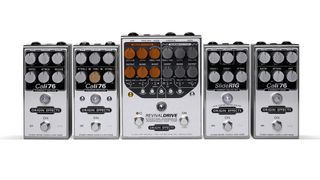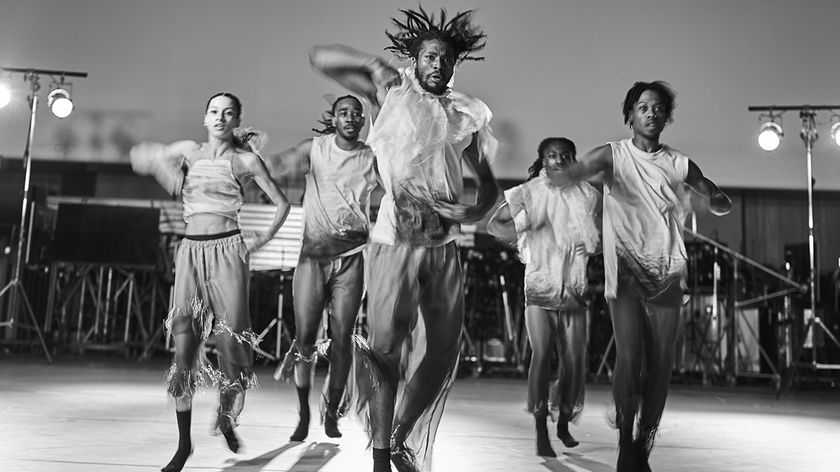
Origin Effects’ chief designer Simon Keats talks gain stacking and explores how to enhance your dynamic range...
1. What was the first pedal you built and how did the design come about?
“The first Origin Effects units were the Cali76 and the SlideRIG [compressors], and they were designed simultaneously.
“Prior to that, I was doing a lot of repair work for various London studios and I’d come across the [UREI] 1176 [LN Peak Limiter]. When I was repairing them, I thought it would be great to have a pedal that does what they do, so our compressors are based on those.
“At the same time, I developed an overdrive pedal and that’s now become the RevivalDRIVE.”
2. What’s your best-selling pedal and why do you think that is?
So many pro players have used 1176s in the studio, once they try our pedals, they’re really into it
“The best-selling pedal is the Cali76 Compact Deluxe, probably because it’s the most mainstream pedal we do. Initially, when we launched the pedals, that one wasn’t doing as well as some of the other units.
Get the MusicRadar Newsletter
Want all the hottest music and gear news, reviews, deals, features and more, direct to your inbox? Sign up here.
“We did a limited-edition run of 200 of the original big box Cali76 version with a germanium boost [Cali76-G] and those units are now going for £1,500!”
3. Which notable players have used Origin Effects pedals?
“The guitar market is so saturated with pedals that marketing only gets you so far. It often takes a while for word of mouth to spread, but we’ve been fortunate with so many artists coming on board from the beginning.
“Because so many pro players have used 1176s in the studio, once they try our pedals, they’re really into it, and I think that helps people’s confidence when it comes to investing in Origin Effects products. There’s a long list of artists on our website [including David Gilmour, Pete Townshend and Ed O’Brien].”
4. What’s new on the horizon at Origin Effects?
“We’re currently working on a bias tremolo pedal for release, hopefully this autumn. It’s based on the RevivalDRIVE technology, which replicates the output stage of a valve amplifier.
“It completely nails that amp tremolo sound. If you play softly, you get more tremolo effect, and as you dig in harder, the output stage breaks up slightly and you can play past the effect. It feels a bit like how players control overdrive with dynamics. When the note decays, the tremolo comes back in, so it’s really nice and tactile.”
5. Tell us a secret about effects...
“We usually recommend people put compressors first in the signal chain because of signal-to-noise ratio issues. Clipping pedals decrease dynamic range anyway, and if you put the compressor towards the end of the chain it’ll often create problems with noise.”

6. What’s your best tone tip?
“If you get a screwdriver and lift the polepieces up on a humbucker and get them closer to the strings, it seems to increase the dynamic range of the pickup. That’s one of the most interesting things I’ve discovered recently!”
7. Name some common mistakes guitarists make with effects...
Even if two players have the same amp and pedal, if they’re using them at different volumes, they can sound quite different
“It seems as if some overdrive pedals are best suited to certain amplifiers, but one of the confusing things is that many amps have a bright cap on the volume control. At full volume, the capacitor isn’t having an effect, but as you turn down, it gets progressively brighter, and with an overdrive pedal that can sound very shrill and buzzy.
“Even if two players have the same amp and pedal, if they’re using them at different volumes, they can sound quite different. On the RevivalDRIVE we have a switch called [Bright Cap] that will undo that effect - you simply adjust it and the response flattens out.”
8. What’s your favourite vintage pedal and why?
“I was lucky enough to visit David Gilmour’s lock-up and compare a load of original Uni-Vibes. There are a lot of subtleties that the new ones don’t really replicate. The lightbulb introduces so many variables that are quite a technical challenge to replicate accurately. I’d love to get to work on solving that.”
9. What pedals are on your own effects ’board?
“I use the RevivalDRIVE set up like a 50-watt Marshall and I hit that with either my old Vox [V828] Tone Bender, an op-amp overdrive like a Tube Screamer, or a Fuzz Face reissue I modified with low-gain transistors for a gritty boost.
“Gain stacking is something a lot of pro guitarists do, it seems. I’ve also got a ’68 Vox wah-wah, which is cool.”
10. What are your favourite effects moments on record and why?
“I like a band called The Twilight Singers and there’s a song called Esta Noche [from Blackberry Belle, 2003] that has a screaming delay sound. I was at one of their shows and the guitarist told me it was a wah plugged in backwards! It’s like the Pink Floyd Echoes ‘seagull’ effect.”
Guitarist is the longest established UK guitar magazine, offering gear reviews, artist interviews, techniques lessons and loads more, in print, on tablet and on smartphones Digital: http://bit.ly/GuitaristiOS If you love guitars, you'll love Guitarist. Find us in print, on Newsstand for iPad, iPhone and other digital readers

“This golden gain machine covers the entire spectrum from gritty boost through to full-on fuzz”: Great Eastern FX’s Focus Fuzz Deluxe has got boost, drive, octave, fuzz... everything going on

“This is the only tremolo pedal in the world that lets you plot your own waveform shapes using controls you first got to grips with as a child”: SoundLad Sketchy review












